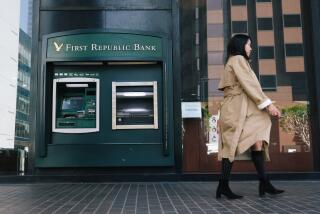S&L; Woes Need Not Worry Most Depositors
- Share via
Could you lose your money in a troubled bank or savings and loan? Might you be forced to wait for weeks or months to get it out if that institution is closed?
Such questions are increasingly being asked by worried savers amid the almost daily barrage of headlines about the mounting costs of the thrift bailout and the woes of such prominent S&Ls; as Columbia Savings and Great American Bank. These questions are likely to persist as federal regulators--under pressure to accelerate the $200-billion-plus bailout--step up efforts to seize ailing thrifts and dispose of their assets.
Here are some answers to frequently asked questions about troubled banks and thrifts:
* How solid is federal deposit insurance?
As solid as the full faith and credit of Uncle Sam. The Federal Deposit Insurance Corp., which insures deposits in banks and thrifts, can borrow from the U.S. Treasury if necessary.
If the FDIC is ever unable to pay a penny of insured deposits--an event that has never happened--the entire nation will be in a deep financial crisis. Not even Treasury bills will be safe.
But while deposit insurance is solid, its terms may change. There is talk in Washington about such reforms as lowering the $100,000 limit or restricting savers to only $100,000 in total insurance, even if they spread their money to several institutions.
* How do I know if my bank or thrift is troubled?
You can get a list of the more than 300 thrifts placed in conservatorship (the initial step in a government takeover) from the Resolution Trust Corp., the federal agency managing the thrift bailout. Write: RTC Reading Room, 550 17th St. N.W., Washington, D.C. 20429. They may bill you for a copying charge.
Concerning other institutions that are insolvent or weak but have yet to be seized, you can request financial information from them directly. But most folks can’t make heads or tails of the complex data.
Read the business pages for such warning signs as mounting quarterly losses or increases in reserves for loan losses, says Robert K. Heady, publisher of Bank Rate Monitor, a North Palm Beach, Fla., newsletter.
Bank Rate Monitor’s sister publication, 100 Highest Yields (P.O. Box 088888, North Palm Beach, Fla. 33408-8888), tracks institutions offering high-yielding certificates of deposit and provides rankings of those firms’ financial strength. Those rankings are provided by Veribanc, one of several independent services that rate financial conditions of banks and thrifts. For information about Veribanc’s services, write Box 461, Wakefield, Mass. 01880, or call (800) 44-BANKS.
Bauer Financial Reports, another such service, sells lists of troubled and safe institutions. For more information, write P.O. Drawer 145510, Coral Gables, Fla. 33114-5510 or call (800) 447-0011.
But be wary. These and other services are not foolproof, and they are using data that could be made obsolete by fast-moving events.
* What happens when regulators seize my institution?
Nothing initially. You continue to receive the same rate of interest on your CD, and your accounts are fully insured up to the $100,000 limit, Heady says. “You can still write checks on your accounts and make cash withdrawals,” he says.
Behind the scenes, regulators replace the old management team and send in auditors to review the books to decide which of three options to pursue: sell the institution, transfer just its deposits to another institution or close it outright. This process can take months, Heady says.
* What are the risks of keeping my money at a thrift in conservatorship?
As long as your money is fully insured within the $100,000 limit, you won’t lose your principal. However, if the thrift is closed or sold, you could lose your CD rate. That’s because institutions assuming the deposits of failed thrifts have been allowed to repudiate the CD rates of the failed institutions within 14 days. You won’t be charged an early withdrawal penalty if you withdraw your money at that point, but you might have to accept a lower rate elsewhere.
“If rates have gone down, that’s a big risk,” says Paul A. Bauer, president of Bauer Financial Reports.
The RTC is expected to approve a proposal later this month to require institutions taking over failed thrifts to honor the old CD rates for at least three months. That would be good news for savers, but you’d still face an early termination.
Another risk: If a thrift or bank is eventually closed and there is a deposit payout, you will lose interest earnings for the few days your money sits idle.
With these risks, keeping money in a troubled institution may not be worth it, Bauer says. If you already have money in a CD--and it’s fully insured--it’s not worth taking the early withdrawal penalty to get it out of a troubled institution. But once the CD matures, move it to a healthy institution, he urges.
* What does it mean if my thrift is switched from conservatorship to receivership?
“Nothing, really,” Heady says. “The switch is done to close the old thrift and open a new institution in its place, a step that may make selling the institution easier. There’s no change in your CD rate, and your checks are still good.”
* What are the chances that a thrift in conservatorship will be closed?
Not high. Closing thrifts--and thus paying off all insured depositors--costs the feds big bucks. Therefore, it’s more likely that your insured deposits will be transferred to another institution. But the chances of a closure are greater at smaller institutions, because closing them is not as expensive, Bauer says.
* What happens when my deposits are transferred?
You’ll receive a notice by mail that you’re now a customer of another institution, most likely a bank. The notice may also describe what will happen to your account.
* What happens if my thrift is closed? How long will I have to wait for my money?
If you can visit the institution in person, you probably can get your money out within one or two days. Otherwise, it could be as long as one to three weeks--the time it takes for you to receive and send back a form verifying your deposit and taking care of other administrative details.
You may run into problems--and wait much longer--if you have more than $100,000 in your name at the institution or if you participate in multiple accounts that total more than $100,000, Heady says. “Then, regulators may require additional proof of ownership,” he says. This could take weeks or even months.
Bill Sing welcomes readers’ comments and suggestions for columns but regrets that he cannot personally answer letters. Write to Bill Sing, Personal Finance, Los Angeles Times, Times Mirror Square, Los Angeles, Calif. 90053.
More to Read
Inside the business of entertainment
The Wide Shot brings you news, analysis and insights on everything from streaming wars to production — and what it all means for the future.
You may occasionally receive promotional content from the Los Angeles Times.










